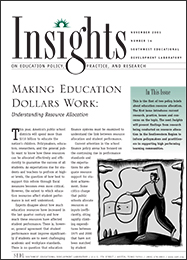Resource Allocation in the Southwest Region
 A recent study of resource allocation in Texas school districts provides new information about the link between student performance and spending within the Southwestern Region (Alexander et al., 2000). Districts were identified as high-, middle-, or low-performing. Researchers found that, on average, high-performing districts spent more per pupil than other districts. They allocated more proportionally to general administration, co-curricular activities, and other operating expenditures (such as transportation, food, plant maintenance, security, and data processing). However, they spent less proportionally than middle- or low-performing districts on instruction, school and instructional leadership, and guidance and counseling. Interviews with district administrators from seven of the high-performing districts revealed several innovative and effective practices that might have con-tributed to their success. These practices included the use of data to make instructional decisions, creation of elaborate "grow-your-own" teacher preparation programs, use of performance pay and sanctions tied to student performance, collaborative methods of drafting district/school budgets, and allocation of funds based on student need rather than on a per-pupil basis.
A recent study of resource allocation in Texas school districts provides new information about the link between student performance and spending within the Southwestern Region (Alexander et al., 2000). Districts were identified as high-, middle-, or low-performing. Researchers found that, on average, high-performing districts spent more per pupil than other districts. They allocated more proportionally to general administration, co-curricular activities, and other operating expenditures (such as transportation, food, plant maintenance, security, and data processing). However, they spent less proportionally than middle- or low-performing districts on instruction, school and instructional leadership, and guidance and counseling. Interviews with district administrators from seven of the high-performing districts revealed several innovative and effective practices that might have con-tributed to their success. These practices included the use of data to make instructional decisions, creation of elaborate "grow-your-own" teacher preparation programs, use of performance pay and sanctions tied to student performance, collaborative methods of drafting district/school budgets, and allocation of funds based on student need rather than on a per-pupil basis.
The Texas study of resource allocation provided new information useful to state and local policymakers, yet many questions regarding resource allocation in the state and across the Southwestern Region remain unanswered. As a result, SEDL and the Charles A. Dana Center at The University of Texas at Austin are undertaking a larger research study to gain an in-depth understanding of resource allocation in relation to student performance in public school districts across the region. Through the analysis of existing data collected and reported by states in SEDL's region, the study will explore differences in district spending in relation to varying levels of student achievement. SEDL and the Dana Center also will assess patterns in resource allocation practices and challenges related to high student performance through in-depth studies of school districts that have exhibited consistent, sustained performance improvement over time. The research results will shed light on the effects of state policies related to the adequacy of funding for school districts and provide state and local decision makers with information and strategies for improving the allocation of resources to support student success. For more information about these policy research projects, contact SEDL at 800-476-6861, visit SEDL's Web site at www.sedl.org, or visit the Dana Center Web site at www.utdanacenter.org.
Next Page: Getting Results: Tools to Explore Resource Allocation

